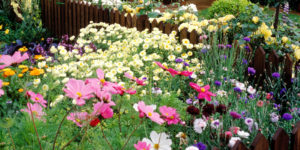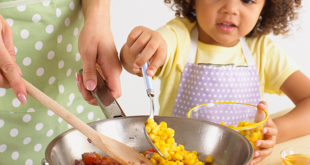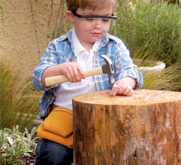 Spring has sprung – it’s time to start growing things!
Spring has sprung – it’s time to start growing things!
Though lessons in all parts of the curriculum can apply to the spring season of growth, we’ll focus on the practical life activities of growing plants, caring for the garden, and enjoying the results. The possibilities are endless but depend on your particular environment. Gardens in schools have been shown to have multiple benefits for children (gardenorganic.org.uk) – be sure to include vegetables along with flowers.
Adapt the following ideas and suggestions to fit your classroom and school. Planting, caring for, and harvesting a garden allow children to use much of what they’ve already learned, whether it’s science, math, or writing. Prepare lessons in advance for any activity you choose to include, being sure all the materials are at hand and that the process works for your particular children and classroom.
Starting the Seeds
Most plants begin as seeds. Even if you eventually plant seedlings purchased from the nursery, children like to watch seeds sprout. A few ideas follow:
- Place the seeds (Lima or fava beans work well) between blotter paper and the glass sides of a jar. Fill the jar with enough water to keep the blotter paper damp. Place in a warm location and watch the seeds sprout.
- Try placing a seed in a clear plastic bag with a damp ball of cotton. Each child might have a different seed, so label the bags accordingly in order to compare the growths of each. You can tape the bags onto a sunny window and watch the seeds root.
- Once seeds have germinated, plant them in pots or in the garden.
- Children can keep track of the time it takes seeds to sprout. They must also watch to make sure they keep them damp.
- Seeds can also be started indoors in flats or small pots and later transplanted.
Preparing the Soil and Planting
Whether you have a large garden or are using large outdoor planters or inside pots, preparing the soil is the first step, with lots of options for children to participate.
- Prepare your lessons in advance so you can show the children how to turn over the soil, remove the seedling from the pot, plant the seedling properly, water it, walk around the plants, etc.
- Outside, children can rake away leaves and winter debris. They love to cultivate with child-sized shovels, rakes, or trowels. (You might have parents or staff do some initial cultivation and soil enrichment so that it isn’t too hard for the children to turn over the soil).
- Using string, show them how to make straight rows for the plants. Mark the place for each seedling with sticks or toothpicks in the ground, showing children how to measure the proper distance between plants.
- Discuss which plants to place where and why – where the sunshine is, how big the plant will grow, etc.
- Dig holes for the seedlings. (Some teachers prefer to use seedlings purchased from the nursery for better growth and survival.) Children plant each seedling carefully and securely, then water with a gentle spray from the watering can. (Hoses are difficult for the young child to control.)
- Label the plants with signs and pictures. Children might use the seed packets or make drawings of the plants. These might be attached to tongue depressors or dowel sticks. Inexpensive wooden spoons can be used with the label drawn or attached to the spoon and the handle stuck into the ground.
- With limited space, inside planting might include mixing soil, planting the seedling, and then sending the individual pots home with the children. They will know how to care for their plant after caring for the ones at school.
Maintaining and Harvesting
Children can care for the garden after they learn how to weed and water properly. At some schools these chores are assigned on a rotating basis, or several children can work together. If planned carefully, there might be foods to harvest in the early spring (lettuce, parsley, strawberries) and then later in the summer or early fall (corn, tomatoes, pumpkins). Flowers might be picked as well. Organize practical life activities around your harvest.
- Cut flowers for the flower arranging exercise daily or weekly.
- Feed lettuce and parsley to the school’s pet rabbit or guinea pig.
- Wash and slice carrots or zucchini to share.
- Use fresh herbs in the smelling jars.
Outdoor practical life activities can continue almost year-round, as you adapt the exercises to your own environment and season of the year. But best of all, gardening activities provide benefits beyond those of practical life. Children will be using many of their intellectual and physical skills in cooperation with others in the real world.
“It is important to notice, in passing, that these are real, not make-believe activities and that they are carried out in a real and not make-believe environment.”
—E. M. Standing, Maria Montessori, Her Life and Work
 Montessori blog Montessori blog
Montessori blog Montessori blog 
